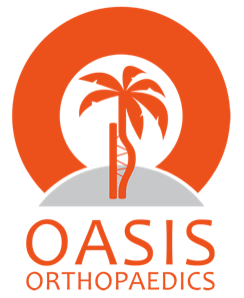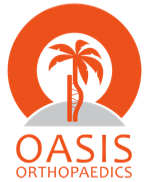
700 Glenhuntly Road
Caulfield VIC 3162
03 9044 4555

700 Glenhuntly Road
Caulfield VIC 3162
03 9044 4555
Femoro-Acetabular Impingement
Femoro-acetabular impingement (FAI) is a clinical syndrome where the parts of the femur and the acetabulum that would normally move smoothly without colliding actually bump into each other. This can result restriction of movement and may cause damage at the margin of the hip socket to a structure called the acetabular labrum. This may lead to pain. It is thought that damage to the labrum by this mechanism is one possible cause for a hip in a young patient to become arthritic in middle-age.
There are two broad types of impingement. The first type, described as “cam impingement” or more recently as “intrusion impingement” occurs when a normally shaped spherical acetabulum is damaged by a non-spherical femoral head trying to “force” it’s way into the hip joint during what is otherwise a normal range of movement of the hip. This is usually a combination of flexing forward at the hip and inward rotation of the femur (e.g. as you would do if you had to reach the outer part of your shoe if you were sitting in a chair, without crossing your legs). As this occurs (and with repeated activity), the relatively oversized non-spherical portion of the femoral head forces the labrum outwards from the bony margin of the acetabulum, damaging its connection with the articular cartilage of the acetabulum and exposing the adjacent edge of the acetabular articular cartilage to further mechanical damage. This is known as a chondrolabral separation and is also called (slightly inaccurately) a “labral tear”. The actual labrum itself may not tear initially, but it does “tear away” from the edge of the acetabulum, resulting in an abnormal gap between the articular cartilage (“chondro”) of the acetabulum and the labrum. The chondrolabral separation results in an ineffective seal from the damaged labrum, with relative loss of lubricating synovial fluid from the hip joint, resulting in less smooth gliding of the femur in the acetabulum.
At the same time, further intrusions of the non-spherical portion of the femoral head into the acetabulum will result in further damage to the exposed margin of the articular cartilage lifting it up at the torn margin, much like lifting a rug up off the floor by picking it up at the edges. These two consequences – loss of lubrication and mechanical injury to the acetabular articular cartilage are thought to result in early hip osteoarthritis in cam/intrusion impingement. If diagnosed before there is irreversible cartilage damage (and thus the hip joint becomes arthritic), it may be possible to surgically reshape the femoral head to become much more spherical (and possibly repair the labrum back to the acetabular margin if necessary)
The second type of impingement is described as “pincer impingement” or also known as “impaction impingement”. In this case, the femoral head has a normal spherical shape, but the margins of the acetabulum are abnormally prominent or elongated, such that the femoral head itself glides smoothly throughout the acetabulum, but the margins of the acetabulum (i.e. the labrum, usually) collides with the portion of the femur just below the head – the femoral neck. This form of impingement results in a more direct crushing injury to the labrum, causing it to either shred (more of a true “labral tear”) or become calcified. At the same time, the impingement of the femoral neck against the margin of the acetabulum may cause the femoral head to be forcefully levered against the opposite side of the acetabular articular cartilage, damaging the articular cartilage at the back of the hip joint. Again, the end result is similar, with a damaged labrum causing loss of a fluid seal and leakage of synovial lubricating fluid as well as mechanically damaged articular cartilage, the end result is early adult hip osteoarthritis. The treatment for this may be performed by surgically shaving back the overly prominent bony edge of the acetabulum while taking pressure off the articular cartilage and remaining labrum (or repairing the labrum if possible, back to the margin of the acetabulum).
It is worth noting that in any patient, their FAI may be related to pure femoral head intrusion, or to pure impaction at the margins, or it is possible to have a combination of the both problems in the one hip joint. In rarer cases, known as acetabular or femoral retroversion, it is possible to have a normally shaped acetabulum and femoral head, however either one of these structures may be facing the wrong direction compared to normal (almost always facing too far backwards), which in turn results in an impaction type pattern of impingement. The importance in recognising this is that due to the femoral head or acetabulum facing the wrong direction but being normal in shape, simply removing a piece of bone (as is done in the other conditions) may help in treating the symptoms but won’t really address the underlying problem. In some instances, it may even make things worse, as removing bone from a normally shaped (but wrongly facing) acetabulum will result in less contact surface for that hip joint and may cause it to become an unstable joint or may weaken the proximal femur unneccesarily if the femur is operated on. It may be more wise to perform surgery to re-direct the position of the acetabulum or the upper femur by an “osteotomy” procedure.
There are two broad types of impingement. The first type, described as “cam impingement” or more recently as “intrusion impingement” occurs when a normally shaped spherical acetabulum is damaged by a non-spherical femoral head trying to “force” it’s way into the hip joint during what is otherwise a normal range of movement of the hip. This is usually a combination of flexing forward at the hip and inward rotation of the femur (e.g. as you would do if you had to reach the outer part of your shoe if you were sitting in a chair, without crossing your legs). As this occurs (and with repeated activity), the relatively oversized non-spherical portion of the femoral head forces the labrum outwards from the bony margin of the acetabulum, damaging its connection with the articular cartilage of the acetabulum and exposing the adjacent edge of the acetabular articular cartilage to further mechanical damage. This is known as a chondrolabral separation and is also called (slightly inaccurately) a “labral tear”. The actual labrum itself may not tear initially, but it does “tear away” from the edge of the acetabulum, resulting in an abnormal gap between the articular cartilage (“chondro”) of the acetabulum and the labrum. The chondrolabral separation results in an ineffective seal from the damaged labrum, with relative loss of lubricating synovial fluid from the hip joint, resulting in less smooth gliding of the femur in the acetabulum.
At the same time, further intrusions of the non-spherical portion of the femoral head into the acetabulum will result in further damage to the exposed margin of the articular cartilage lifting it up at the torn margin, much like lifting a rug up off the floor by picking it up at the edges. These two consequences – loss of lubrication and mechanical injury to the acetabular articular cartilage are thought to result in early hip osteoarthritis in cam/intrusion impingement. If diagnosed before there is irreversible cartilage damage (and thus the hip joint becomes arthritic), it may be possible to surgically reshape the femoral head to become much more spherical (and possibly repair the labrum back to the acetabular margin if necessary)
The second type of impingement is described as “pincer impingement” or also known as “impaction impingement”. In this case, the femoral head has a normal spherical shape, but the margins of the acetabulum are abnormally prominent or elongated, such that the femoral head itself glides smoothly throughout the acetabulum, but the margins of the acetabulum (i.e. the labrum, usually) collides with the portion of the femur just below the head – the femoral neck. This form of impingement results in a more direct crushing injury to the labrum, causing it to either shred (more of a true “labral tear”) or become calcified. At the same time, the impingement of the femoral neck against the margin of the acetabulum may cause the femoral head to be forcefully levered against the opposite side of the acetabular articular cartilage, damaging the articular cartilage at the back of the hip joint. Again, the end result is similar, with a damaged labrum causing loss of a fluid seal and leakage of synovial lubricating fluid as well as mechanically damaged articular cartilage, the end result is early adult hip osteoarthritis. The treatment for this may be performed by surgically shaving back the overly prominent bony edge of the acetabulum while taking pressure off the articular cartilage and remaining labrum (or repairing the labrum if possible, back to the margin of the acetabulum).
It is worth noting that in any patient, their FAI may be related to pure femoral head intrusion, or to pure impaction at the margins, or it is possible to have a combination of the both problems in the one hip joint. In rarer cases, known as acetabular or femoral retroversion, it is possible to have a normally shaped acetabulum and femoral head, however either one of these structures may be facing the wrong direction compared to normal (almost always facing too far backwards), which in turn results in an impaction type pattern of impingement. The importance in recognising this is that due to the femoral head or acetabulum facing the wrong direction but being normal in shape, simply removing a piece of bone (as is done in the other conditions) may help in treating the symptoms but won’t really address the underlying problem. In some instances, it may even make things worse, as removing bone from a normally shaped (but wrongly facing) acetabulum will result in less contact surface for that hip joint and may cause it to become an unstable joint or may weaken the proximal femur unneccesarily if the femur is operated on. It may be more wise to perform surgery to re-direct the position of the acetabulum or the upper femur by an “osteotomy” procedure.
The information above is general. All surgical procedures involve some risk. If you would like advice on your specific condition, please contact Oasis Orthopaedics to make an appointment with one of our specialists.
